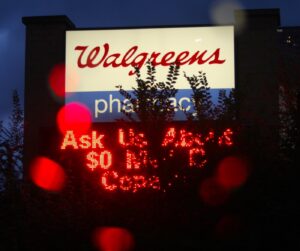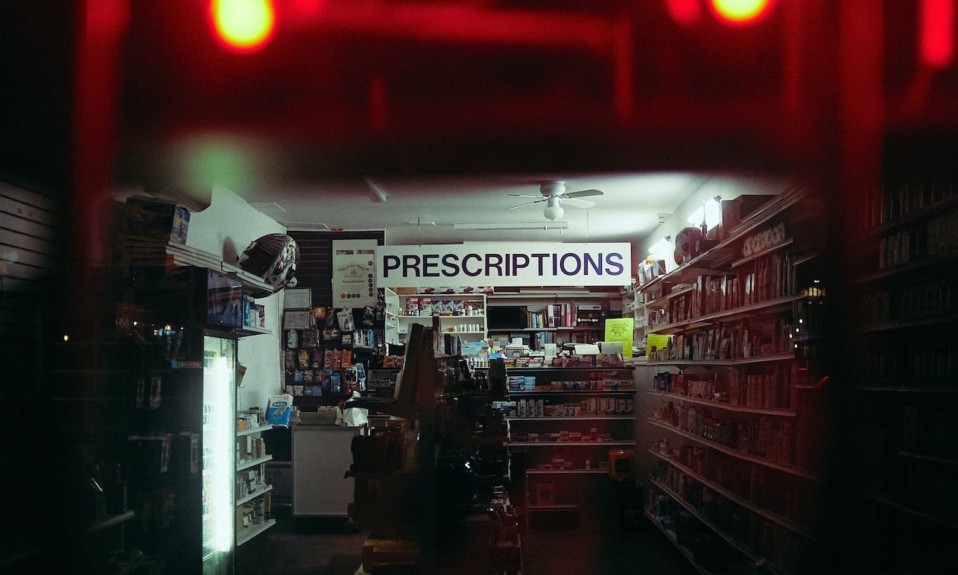For all intents and purposes, the entire opioid crisis is currently on trial in a courtroom in Charleston, W.Va.
By Mark Mravic
The first principle of the digital age may be: Don’t put anything in an email that you wouldn’t want read out in a court of law. It’s safe to say executives with the pharmaceutical company AmerisourceBergen didn’t have that guidance in mind when they shared a 2011 email among colleagues. Originally sent by an AmerisourceBergen corporate investigator at the time, the email reads:
To the Tune of the Beverly Hillbillies
Come and listen to a story about a man named Jed
A poor mountaineer, barely kept his habit fed,
Then one day he was lookin at some tube
And saw that Florida had a lax attitude
About pills, that is, Hillbilly Heroin, OC
Well the first thing you know ol’ Jed’s a drivin South
Kinfolk said Jed don’t put too many in your mouth
Said Sunny Florida is the place you ought to be
So they loaded up the truck and drove speedily.
South, that is.
Pain Clinics, cash ’n carry.
A Bevy of Pillbillies!
The email goes on from there, but you get the idea.
Over the past decade, thousands of lawsuits have been filed by states and municipalities against drug companies for their role in the opioid epidemic, which has claimed the lives of a half-million Americans since the late 1990s. But if you’re wondering why you haven’t heard much detail about testimony in these court cases, it’s because there hasn’t been much testimony.
That email helps explains why. While drug makers, distributors and pharmacies continue to battle the notion that they’re responsible for hooking millions of Americans on opioids, they really don’t want their cases heard in court—where they’re subject to rules of discovery bringing to the surface evidence that is at best embarrassing and at worst damning.
Just how complicated is the issue? The hundreds of plaintiffs in the MDL range from cities, counties and states to Chicago Public School District 299 and Local 713 of the International Brotherhood of Trade Unions on Long Island.”
The “pillbillies” email—as well as others mocking the residents of Appalachia and people addicted to opioids—emerged in a trial underway in the U.S. District Court in Charleston, W.Va. The first opioid case to be heard in a federal court and just the second in the nation to go trial, it pits Cabell County, W.Va., and its major city, Huntington, against America’s “Big Three” prescription drug distributors: AmerisourceBergen, McKesson Corporation and Cardinal Health. The county and city contend that the distributors are liable for the soaring addiction rates that have devastated their communities, by pumping massive numbers of highly addictive opioids into the region while flouting systems to detect suspicious orders and ignoring other red flags. The distributors counter that they were simply filling legitimate orders from doctors who were prescribing more opioids because of evolving standards of pain treatment, and that the failures came at the hands of the Drug Enforcement Agency (DEA), Food and Drug Administration (FDA) and other agencies tasked with regulating prescription drugs. Testimony in the case began on May 3.
Why West Virginia?
Right now there are some 3,000 active opioid lawsuits nationwide against the drug industry. But because such litigation is intricately complex, and the sheer number of cases would place an enormous burden on judicial resources, most have been consolidated into a single massive case—the legal term is “multidistrict litigation” (MDL)—overseen by Judge Dan Aaron Polster in the U.S. District Court for Northern Ohio. He has the unenviable task of marshalling the participants, weighing the manifold arcane legal points and trying to find a resolution across all of those suits. Given the immediacy of the crisis and the urgent need for money to address it, Judge Polster has consistently encouraged the sides to reach a settlement that would allow everyone to move ahead.

Just how complicated is the issue? The hundreds of plaintiffs in the MDL range from cities, counties and states to Chicago Public School District 299 and Local 713 of the International Brotherhood of Trade Unions on Long Island. The defendants include a dizzying array of drug manufacturers and distributors, and their subsidiaries; dispensers ranging from Walmart, Walgreens and CVS to Ernie’s Pharmacy in Muskogee, Okla.; and dozens of doctors and other private individuals. The number of lawyers—surprise—reaches into the hundreds.
Finding a consensus among all those competing interests is like herding cats—thousands of cats. In 2019, a proposed $48 billion settlement was rejected by towns and states, which clashed with the state attorneys general who negotiated the deal over how the funds would be shared out, and how quickly. Last November the Big Three distributors—which generated a combined $575 billion in revenue in 2020—and manufacturer Johnson & Johnson proposed their own $26 billion settlement. That agreement was met positively from plaintiffs but remains in legal limbo.
And then there’s West Virginia. In 2019, the state reached settlements with the Big Three worth more than $50 million. But counties and municipalities continue to pursue their own cases—and they are opting out of the proposed $26 billion nationwide deal. Paul T. Farrell Jr., who represents many West Virginia localities in the litigation, including Cabell County and Huntington in the current trial, told the Mountain State Spotlight in November, “West Virginia fully supports the national settlement on behalf of every other state. Everybody understands that any national settlement does not account for West Virginia. There’s no dispute about that.”
Indeed, West Virginia had the highest rate of opioid overdose deaths in the country in 2018, at 42.4 per 100,000 people. That’s nearly three times the rate of New York or Florida, and eight times the rate in California. And Cabell County has been the epicenter of the disaster. Its rate of overdose deaths in 2018 was 162 per 100,000, nearly twice that of any other county in the already battered state.
Hence the case playing out now in front of U.S. District Court Judge David A. Faber at the Robert C. Byrd courthouse in the state capital, in which Cabell and Huntington seek $2.6 billion—about 10 times what the state as a whole might receive in the proposed $26 billion settlement. Judge Polster in Ohio has designated the West Virginia trial the first “bellwether” case for the federal MDL, meaning it will serve as a proving ground for the arguments from each side, test the evidence and legal issues, provide a road map for future cases and—just possibly—ramp up the pressure for a negotiated national settlement.
Revelations So Far in the West Virginia Case
In his opening statement, Farrell said, “We intend to prove the simple truth that the distributor defendants sold a mountain of opioid pills into our community, fueling a modern opioid epidemic.” In response, Paul Schmidt, a lawyer for the distributors, said, “Every one of those prescriptions dispensed was supposed to be dispensed because of a doctor sitting across from a patient.” He added that that the Big Three were simply “logistics” companies—conduits between the manufacturers and the dispensers, and bear no responsibility for the region’s addiction crisis.
The case’s legal arguments hinge on the notion of “public nuisance,” a broad and elastic principle that communities can wield to combat what they see as harm to the public interest. “The whole point of public nuisance is that it is a flexible doctrine,” Prof. Tracy Hester of the University of Houston told Law360. “It’s been applied to everything from road impediments to water pollution to houses of prostitution.” In this case, the West Virginia communities must prove that the distributors were knowingly contributing to the opioid epidemic, or reckless in their ignorance. Experts say finding that smoking gun may be difficult.
A data expert called by the plaintiffs testified to the unusually high number of prescription opioids that flooded the region. From 2006 to 2014, 110 million doses of hydrocodone and oxycodone were pumped into Cabell County, amounting to 122 doses for every citizen.”
Some of the key points to emerge from the trial so far:
- On the opening day, the West Virginia communities presented testimony of the gateway effect of prescription opioids to illicit heroin and fentanyl, a major point of contention between the sides. As reported by Law360, Corey Waller, M.D., managing director of the Institute on Addiction and an emergency medicine professional, testified to a “clear connection” between prescription opioids and heroin use. “It’s not a gateway theory, really—the brain doesn’t know [which] drug you just gave it,” Waller said. Lawyers for the distributors downplayed the notion that people wouldn’t be addicted to heroin “but for the fact that they got a single opioid prescription for a root canal.”
- A data expert called by the plaintiffs testified to the unusually high number of prescription opioids that flooded the region. From 2006 to 2014, 110 million doses of hydrocodone and oxycodone were pumped into Cabell County, amounting to 122 doses for every citizen. Lawyers for the distributors argue that the inordinately high numbers of painkillers shipped to the region could be accounted for by the dangers of the coal-mining industry and other hazardous jobs the area is known for.
- A former DEA investigator testified to the “widespread” failure of the Big Three to report suspiciously large prescription opioid orders, despite numerous warnings, or to establish proper systems to prevent diversion to the black market. Lawyers for the distributors contended that the DEA approved higher manufacturing quotas for prescription opioids, failed to provide standards to identify suspicious orders (each distributor had its own system for flagging them) and didn’t keep track of reports that were filed.
- A Cardinal Health executive who led the company’s anti-diversion unit in the late 2000s told the court that staffing was insufficient to meet Cardinal’s regulatory obligations, and that improvements he implemented did not solve the problems. Emails from McKesson employees charged with monitoring shipments similarly said they were overworked and had difficulty fulfilling their duties.
- Lawyers for the city and county noted that in one month in 2008, Cardinal Health’s system flagged 800 suspicious transactions, but only two were reported to the DEA. In some months that year there were no DEA reports at all from Cardinal.
- A 2012 email from a Cardinal employee that was displayed at the trial noted a suspiciously large order from a pharmacy in Huntington that he characterized as a “black hole.” According to the Mountain State Spotlight, despite six requests from inside Cardinal to look into the pharmacy, no in-person inspection was carried out. That drugstore was part of the Medicine Shoppe chain, which is owned by Cardinal Health.
- Two memos sent by McKesson told its employees “to refrain from using the word ‘suspicious’” when describing the sharp rise in opioid orders from pharmacies. A company executive explained to the court that “once you use that word, you need to take action. We just didn’t want that label on a customer we deemed not suspicious.”
- Cabell County Sheriff Chuck Zerkle testified to the damage wrought by the opioid epidemic in the community. He said the jail system was overwhelmed by people who’d turned to crime to feed their drug habit, and that the burden of the opioid epidemic has strained the resources of the county’s first responders to the breaking point. He also testified that he fears for the future of the community, noting that 350 homes went unsold by the county after owners failed to pay their taxes. “We’ve got this publicity of being the opioid epicenter. … This is bad. If you were a major company, would you want to come here?” he said, adding, “I fear for what comes for my grandchildren and the next generation.”
The trial is scheduled to last through mid-August.

Other Opioid Trials Across the Country
In April, Judge Polster designated five more federal cases to serve as bellwethers for the consolidated litigation, in North Carolina, Texas, Ohio, New Mexico and Georgia.
To date, only one other opioid trial in the country has run to completion. In 2019, the state of Oklahoma sued several drug companies, but only Johnson & Johnson failed to reach a settlement. After a seven-week bench trial that tested the public nuisance argument, Oklahoma won a $475 million judgment. In his ruling, Judge Thad Balkman found that the defendants engaged in “false, misleading and dangerous marketing” that “compromised the health and safety of thousands of Oklahomans.” He said that was “more than enough” to constitute a public nuisance under the state’s law.
An ‘opioid baby’ trial is set to begin in Tennessee on July 26, in which the state blames Endo Pharmaceutical for ‘neonatal abstinence syndrome,’ a condition among infants born to mothers who used opioids during pregnancy.”
Several other state cases independent of the federal MDL are underway or set to begin:
- In California, opening arguments began in mid-April in a suit brought by Santa Clara, Orange and Los Angeles counties and the city of Oakland, charging drug manufacturers with public nuisance, false advertising and unfair competition. Unlike in litigation elsewhere, the drug makers in this case have disputed the existence of an opioid epidemic in California, where prescribing rates and overdose deaths are among the lowest in the country. “The experts whose boots are on the ground in those jurisdictions will tell you themselves there is no crisis,” a lawyer for Endo Pharmaceutical told the judge. The bench trial, conducted entirely remotely, is being livestreamed.
- A sweeping trial brought by the state of New York, Nassau and Suffolk counties is set to commence on June 22. It will be the first to go before a jury rather than a judge; jury selection began last week. And because of its size—hundreds of witnesses are expected to be called—the venue has been moved to an auditorium at Truro College on Long Island.
- Separate from the federal case in West Virginia, there is also consolidated state litigation involving more than 80 lawsuits by cities, counties and hospitals against drug manufacturers and distributors. Last week the West Virginia supreme court ruled that the case could proceed to a jury trial.
- An “opioid baby” trial is set to begin in Tennessee on July 26, in which the state blames Endo Pharmaceutical for “neonatal abstinence syndrome,” a condition among infants born to mothers who used opioids during pregnancy. In April, Chancellor E.G. Moody of the Sullivan County Circuit Court hit Endo with a default judgment, ruling that the company knowingly failed to produce documents and other evidence and instead engaged in “obfuscation and delay.” Moody found that Endo did not search the records of its more than 100 sales reps or district managers for documents relating to knowledge of suspicious drug activity. The trial will determine damages; the state is seeking $2.4 billion.
And why might Endo have been dragging its feet about evidence it might turn up? Go back to the West Virginia trial and consider another email that circulated among AmerisourceBergen executives and that emerged during proceedings:
(To the tune of “Margaritaville”)
Headin’ for strip malls
Drivin’ till night falls
All of these tourists, carrying cash
Lookin’ for pill mills
For phantom back ills
Gettin’ in line for my Florida stash
Wastin’ away again in OxyContinville …
The landmark West Virginia trial will go far in determining to what extent the drug industry is liable for the opioid epidemic. What it’s already shown is the extent of its contempt for the people its products are intended to help.
Top photo: Patrick Tomasso; middle photo: Sachina Hobo; bottom photo: Scott Rodgerson














